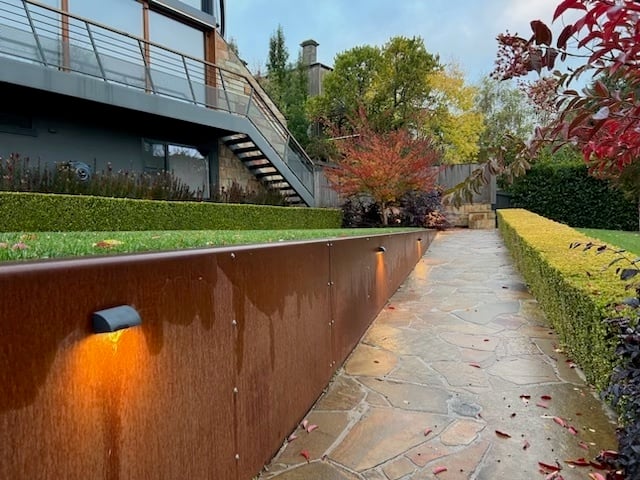
A variation in a landscaping project is when a change needs to be made that will incur additional costs. Literally it's a variation to the original contracted price.
It must be made in writing and given to the client for approval prior to proceeding.
Variations are fairly common due to a number of reasons, but if variations get out of control in a project, it is likely there could be a large budget blowout.
Before undertaking any landscaping project, it's wise to understand what some of the most common variations are, what circumstances lead to them and how to manage them, so you can keep your project costs under control.
In this article we've drawn on our 35+ years of experience designing and building over 550 gardens to help you understand more about variations. It's packed with advice, knowledge and tips, so take a minute to read it through to the end. It will be worth your time.
Here are some of the most common variations you are likely to come across.
VARIATIONS THAT WERE hidden unground
The first type of variation, and a very common one, falls into the category of "no one knew it was there"!
This is where something unknown (often because it was buried underground) is discovered during excavation or landscaping works that affects the planned works. Dealing with it will take either additional time, or money, or both.
This type of variation is the hardest to predict and prevent, because they are usually unknown at the time of commencing the work.
Sometimes these are caused by shoddy work done on the property by a previous owner in an attempt to cut corners. Often they can involve things like electrical cables that should be laid underground at a minimum depth of 600mm. But we've found them just literally laying on the ground under a concrete slab or path or hiding underneath a deck. In all such cases, not only dp these cables present a risk to our crew and the homeowner, they have to be relaid properly by a registered electrician.
Equally frustrating can be plumbing pipes laid incorrectly that sometimes run to nowhere and just stop. (When discovered homeowners will often say "Oh that explains why the back corner of the garden is always wet!") Again the pipes have to be relaid and connected properly to the main drains.
We've also discovered 'things' buried in people's backyards. (No bodies luckily!) But we've found building frames, buried concrete ponds, old foundations, even asbestos! (The cost to dig this up and remove it was a small fortune!)
We once found a whole original brick path, under a known concrete path, that required a great deal of extra work to dig it all up and remove it.
Then there are natural surprises like an unexpected shale or hard rock that requires a special excavator with a breaker tool to smash it up - at additional costs.
All of these, as you can understand, are very legitimate reasons for having to raise a variation for additional costs on the project. They are hard to avoid as they are almost impossible to predict.
Below is an image showing what we found once we started removing an existing deck. Underneath were electrical cables and brick steps and paving that were not known about by the current owner. It took considerable extra work to remove all this and get the wiring re-routed.

'Provisional sum' items THAT NEED a variation
In landscaping contracts, there can be things called 'Provisional Sums'. These are estimated likely costs for materials or works that cannot be accurately costed at the time of the contract signing.
There are also 'Prime Costs' which are allowances for specific, yet-to-be-chosen items or materials, the exact cost of which is unknown at the time the contract is signed.
Naturally, both of these will lead to variations, when the actual cost is discovered at a later stage.
An example of this might be a contract containing the note - 'Paving selection yet to be finalised as stone availability is uncertain'. At the time of signing the contract an allowance of $100/m2 was included to cover purchasing the pavers. But then it is discovered the stone will not be available for months due to a quarry issue overseas. So the designer and client explore other options and discover a stone they both love. But it costs $156.75/m2 and requires special sealing because it is a softer stone. So a legitimate $3000 variation occurs.
A provisional sum may include electrical work. On one project in Essendon (shown below), when the electrician went into the roof of the house, he discovered all the wiring was old, dangerous and non-compliant. It had to be rewired and a new switchboard installed before we could work on installing the pool, outdoor kitchen etc.

The time between signing a contract and work on certain sections can be considerable - year or more. Over that time material costs can change or availability becomes a problem, so alternatives must be found. These can be at a different cost. (Yes, occasionally, they might be cheaper, but that's a variation too!)
One way to reduce the likelihood of variations is trying to avoid too many Provisional Sums or Prime Costs in your contract. But often they cannot be eliminated fully.
Client requested variations
Sometimes a client will find it hard to fully understand the scope of works involved in a landscaping project. It can be an emotional exercise. They may be very nervous at the start, but then as the project starts taking shape, they start getting excited about it.
We had a client with an extensive project in Hawthorn. When it came time to sign the contract, the client got nervous and wanted $100,000 of costs removed. So we did that and got started.
But on the first day, we discovered that the builder doing the renovation before us, hadn't done some of the things he'd promised, leading to delays and extra work from us. As we started the paving, the client requested an item that had been pulled out of the contract to be put back in. (As they are perfectly entitled to do!) As the job evolved, for various reasons the client kept adding items that had been removed from the contract, back into the job. In the end, the whole $100,000 worth of previously removed costs, had all been added back in!

We are all human and open to changing our minds. It happens!
Sometimes it can be that a client didn't really understand a proposed feature that was discussed at the design stage and so they pulled it out. But as the garden starts to take shape and the client can now see for themselves how it will work, they get excited and want it back in again.
Or they might be in the middle of a project and they visit a friend who has heaters in their pergola. The client enjoys being warm outdoors and suddenly they're asking us to install heaters in theirs!
It's natural for people to change their minds as things evolve and we are happy to accommodate. A garden is a major investment and some clients are just eager to grab an opportunity when it arises.
In the long run, the small additional cost is often forgotten when the benefit is being enjoyed. But if you're the excitable type, perhaps you should let your other half run the project if you don't want big cost blowouts!
Contractor-inspired variationS
The design of a garden can take months. By the time we start the actual landscaping works, we may have spent up to a year designing the garden and then obtaining the necessary permits.
Once the works begin, sometimes either the designer or the landscaper can see an opportunity to improve something about the garden. This can occur, because as the site changes due to excavation works or the decking providing an elevated view, something is seen that wasn't envisaged before. Like an opportunity to extend the deck to capture a better view of the bay and watch incredible sunsets.
Designers work off computer plans for the most part. But once the landscaping work is in full swing, the physical view becomes something different and with this, suddenly changes occur.
Just like clients can get excited, so can designers and landscapers! If we see a great opportunity arising on a project we will always tell you about it, because we don't want you to miss out on the potential it offers.
In this example below, the outside walls of the pool were originally designed to be rendered concrete. But once the shell of the pool was poured and the designer and client started looking at it in situ, rather than blending the wall into the landscape, they both decided it might be better to make it a feature so it stands out. Our landscape architect revised the design, then shopped with the client for the ideal tiles and now it is quite the feature. Client is delighted.
So while it's important no one loses their head and gets too excited during the construction stage, it's always wise to seize opportunities, if and when they present themselves. Because often they can't done when the project is completed.
When client or designer originated variations occur because an exciting possibility opens up, there is rarely annoyance at the extra costs involved, compared to when they 'bad surprises' like those detailed in the first section.

compliance variations
Sometimes there are variations that occur due to compliance issues.
This can happen because the contract may need to be signed before all the engineering details and permits are finalised. Rather than hold up the work, it is sometimes smart to get the landscaping started while the compliance documentation is being finalised.
In the project shown below the design included building a concrete sleeper retaining wall. We started work, but when the soil report came back it revealed that when the home was originally built, extra soil fill was used in the rear garden. This 'fill' was unstable so we had to get an engineer to come up with a solution. This involved specifying that the steel uprights be concreted some 3.9m deep into the ground. (That's very, very deep). A special excavator was required to drill such deep holes. As the client was insisting on heavy concrete sleepers this was the only solution and so a variation was required.
Considering the size and scope of the job, this small extra cost ensured a lifetime of stability for that wall.

We hope these examples have helped you understand what some of the most common variations to a landscaping contract are and why they occur.
It's important not to think about variations as just being another example of you being sold something and then later on discovering "oh that's gonna cost you extra"! It's not quite like that, because often the variations are unknown or they crop up during the process - and can be originated by the client!
a few tips to help you avoid variations
A few tips to help you avoid too many variations on yourproject.
First, if you have obtained competitive quotes from 2 or more landscapers, just check very carefully over the cheapest one - particularly if it's radically cheaper than the others. Over the decades we have been 'out-quoted' by other landscapers and then discovered later on that the client was misled by this landscaper who used an old trick. They underquoted by removing some not very obvious aspects of the project in their quote and then, as the work progresses, they start reintroducing them as "variations". In some cases this has led clients to paying more than we quoted, even though their original quote was substantially lower.
So don't be afraid to have an upfront conversation about variations with your landscaper and ask many questions about every aspect of the quote to ensure you are not being locked into a misleading quote.
All projects will tend to have some variation, it's almost impossible to undertake a project without them occurring. But you can minimise their impact by doing a few things.
If you can, find out any detail about previous work on the property. (You can check past permits with the council.) If you share what you discover with us at the briefing we are likely to spot 'red flags' that could lead to hidden issues being uncovered before work commences. Also have a bit of a look around, check under your deck or in your roof. How do things look in there? Anything look suspicious?
Talk to your designer if you think you might be an "excitable client" likely to get carried away with the project. (We can put in place strategies to manage this.)
Ask your landscaper in advance what kind of variations they think might be possible on a project like yours. They can draw on their experience and give you some advice so you can be more prepared for them.
When it comes to the contract, try and minimise provisional sums if you can. And be as decisive as possible about options to minimise the number of non-specified items in the contract.
Above all else, always have a little contingency budget in your back pocket, just in case. If you need it, it's there and it means you can seize a great opportunity if it does arise. And if you don't, well you've got something there to pay for your 'garden-warming' party!
Helpful advice for choosing a landscape designer in Melbourne or the Mornington Peninsula
10 Things you should Know when engaging a Landscaper
Founder of Whyte Gardens
Topics:




